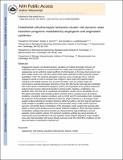Endothelial cell phenotypic behaviors cluster into dynamic state transition programs modulated by angiogenic and angiostatic cytokines
Author(s)
Rimchala, Tharathorn; Kamm, Roger Dale; Lauffenburger, Douglas A
DownloadKamm_Endothelial cell.pdf (2.916Mb)
OPEN_ACCESS_POLICY
Open Access Policy
Creative Commons Attribution-Noncommercial-Share Alike
Terms of use
Metadata
Show full item recordAbstract
Angiogenesis requires coordinated dynamic regulation of multiple phenotypic behaviors of endothelial cells in response to environmental cues. Multi-scale computational models of angiogenesis can be useful for analyzing effects of cell behaviors on the tissue level outcome, but these models require more intensive experimental studies dedicated to determining the required quantitative “rules” for cell-level phenotypic responses across a landscape of pro- and anti-angiogenic stimuli in order to ascertain how changes in these single cell responses lead to emerging multi-cellular behavior such as sprout formation. Here we employ single-cell microscopy to ascertain phenotypic behaviors of more than 800 human microvascular endothelial cells under various combinational angiogenic (VEGF) and angiostatic (PF4) cytokine treatments, analyzing their dynamic behavioral transitions among sessile, migratory, proliferative, and apoptotic states. We find that an endothelial cell population clusters into an identifiable set of a few distinct phenotypic state transition patterns (clusters) that is consistent across all cytokine conditions. Varying the cytokine conditions, such as VEGF and PF4 combinations here, modulates the proportion of the population following a particular pattern (referred to as phenotypic cluster weights) without altering the transition dynamics within the patterns. We then map the phenotypic cluster weights to quantified population level sprout densities using a multi-variate regression approach, and identify linear combinations of the phenotypic cluster weights that associate with greater or lesser sprout density across the various treatment conditions. VEGF-dominant cytokine combinations yielding high sprout densities are characterized by high proliferative and low apoptotic cluster weights, whereas PF4-dominant conditions yielding low sprout densities are characterized by low proliferative and high apoptotic cluster weights. Migratory cluster weights show only mild association with sprout density outcomes under the VEGF/PF4 conditions and the sprout formation characteristics explored here.
Date issued
2013Department
Massachusetts Institute of Technology. Department of Biological Engineering; Massachusetts Institute of Technology. Department of Biology; Massachusetts Institute of Technology. Department of Mechanical EngineeringJournal
Integrative Biology
Publisher
Royal Society of Chemistry
Citation
Rimchala, Tharathorn, Roger D. Kamm, and Douglas A. Lauffenburger. “Endothelial Cell Phenotypic Behaviors Cluster into Dynamic State Transition Programs Modulated by Angiogenic and Angiostatic Cytokines.” Integr. Biol. 5, no. 3 (2013): 510.
Version: Author's final manuscript
ISSN
1757-9694
1757-9708